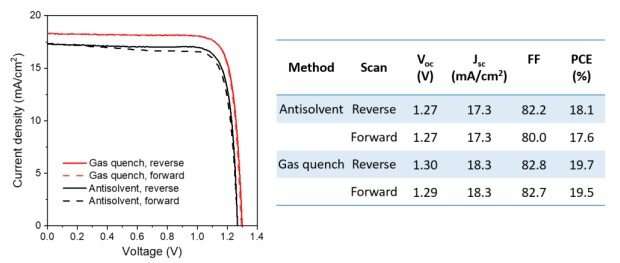New method addresses problem with perovskite solar cells

A new approach to manufacturing perovskite solar cells has addressed previous problems and yielded devices with high efficiency and excellent stability, researchers at the National Renewable Energy Laboratory (NREL) report in the new issue of the journal Science.
Developing highly stable and efficient perovskites based on a rich mixture of bromine and iodine is considered critical for the creation of tandem solar cells. The two elements, however, tend to separate when exposed to light and heat and thus limit the voltage and stability of a solar cell.
“This new growth approach can significantly suppress the phase segregation,” said Kai Zhu, a senior scientist at NREL, principal investigator on the project, and lead author of the new paper “Compositional texture engineering for highly stable wide-bandgap perovskite solar cells.”
The new approach addressed that problem and produced a wide-bandgap solar cell with an efficiency of greater than 20% and 1.33-volt photovoltage and little change in the efficiency over 1,100 hours of continuous operation at a high temperature. With this new approach, an all-perovskite tandem cell obtained an efficiency of 27.1% with a high photovoltage of 2.2 volts and good operational stability.
In the tandem cell, the narrow-bandgap layer is deposited on top of the wide-bandgap layer. The difference in bandgaps allows for more of the solar spectrum to be captured and converted into electricity.
Perovskite refers to a crystalline structure formed by the deposition of chemicals onto a substrate. A high concentration of bromine causes more rapid crystallization of the perovskite film and often leads to defects that reduce the performance of a solar cell. Various strategies have been tried to mitigate those issues, but the stability of wide-bandgap perovskite solar cells is still considered inadequate.
The newly developed approach builds upon work Zhu and his colleagues published earlier this year that flipped the typical perovskite cell. Using this inverted architectural structure allowed the researchers to increase both efficiency and stability and to easily integrate tandem solar cells.
The NREL-led group used that same architecture and moved further away from the conventional method of making a perovskite. The traditional method uses an antisolvent applied to the crystalizing chemicals to create a uniform perovskite film. The new approach relied on what is known as gas quenching, in which a flow of nitrogen was blown onto the chemicals. The result addressed the problem of the bromine and iodine separating, resulting in a perovskite film with improved structural and optoelectronic properties.
The antisolvent approach allows the crystals to grow rapidly and uniformly within the perovskite film, crowding each other and leading to defects where the grain boundaries meet. The gas-quenching process, when applied to high-bromine-content perovskite chemicals, forces the crystals to grow together, tightly packed from top to bottom, so they become like a single grain and significantly reduces the number of defects. The top-down growth method forms a gradient structure, with more bromine near the top and less in the bulk of the cell. The gas-quench method was also statistically more reproducible than the antisolvent approach.
The researchers achieved an efficiency that exceeded 20% for the wide-bandgap layer and operational stability with less than 5% degradation over 1,100 hours. Coupled with the bottom cell, the device reached the 27.1% efficiency mark.
The researchers also tried argon and air as the drying gas with similar results, indicating that the gas-quench method is a general way for improving the performance of wide-bandgap perovskite solar cells.
The new growth approach demonstrated the potential of high-performance all-perovskite tandem devices and advanced the development of other perovskite-based tandem architectures such as those that incorporate silicon.
Qi Jiang et al, Compositional texture engineering for highly stable wide-bandgap perovskite solar cells, Science (2022). DOI: 10.1126/science.adf0194
Citation:
New method addresses problem with perovskite solar cells (2022, December 23)
retrieved 23 December 2022
from https://techxplore.com/news/2022-12-method-problem-perovskite-solar-cells.html
This document is subject to copyright. Apart from any fair dealing for the purpose of private study or research, no
part may be reproduced without the written permission. The content is provided for information purposes only.
For all the latest Technology News Click Here
For the latest news and updates, follow us on Google News.

